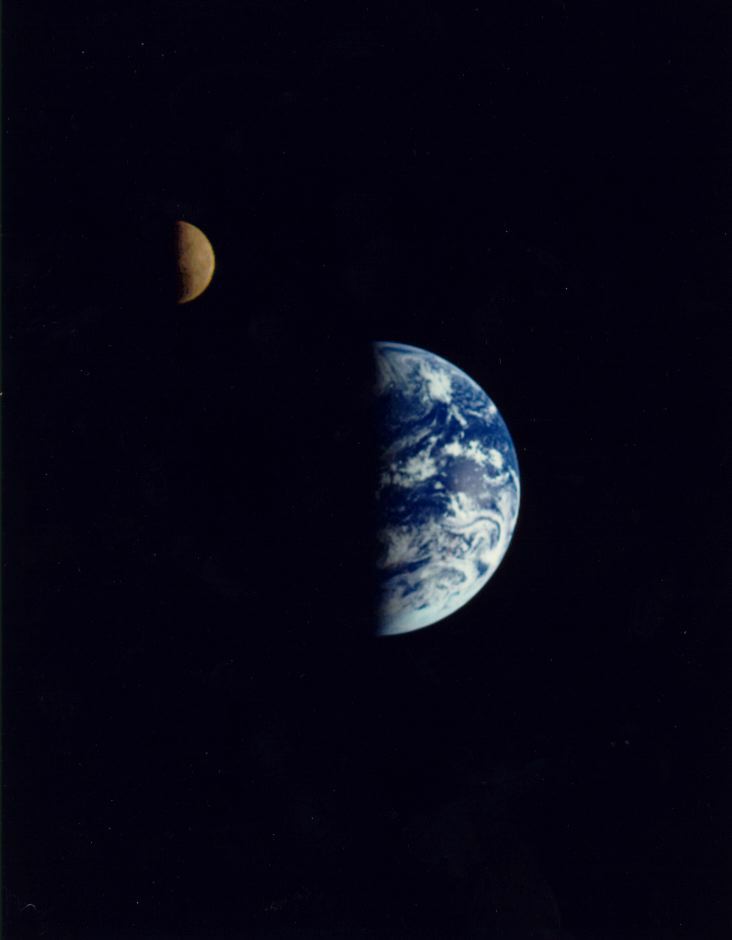bystander wrote:Ann wrote:Do any known rocky bodies of our solar system have largish patches of ground that are "more B than R and G"?
Color enhanced view of the Moon
This is the Moon's true colors! If our eyes were able to detect the subtle color differences, this is what we would see.
The colors are due to different chemical makeup of the moon's crust. Specifically, lavas low in Titanium (TiO2) are red, while lavas with high TiO2 content are blue.
Copyright: SOCIETAS CORONAE BOREALIS - Jan Sonnvik
Click on image for a bigger version.
Thanks, bystander! I have, of course, seen such color photos of the Moon before, but I have never really taken them absolutely seriously. And why? For two reasons. First, it is obvious that the overall color of the Moon is a dark grayish-brown, which is to say that the Moon is clearly "more R than B", so to speak. This is a famous "Earth and Moon" picture by NASA, where the Moon really looks very brownish:
So the overall color of the Moon is a dark grayish-brown. I think there can be little doubt about that. To me, this suggests that the parts of the Moon that look blue in enhanced color pictures might be a "relative blue", that is, they may be considerably bluer than their surroundings, even though they may still not be "an absolute blue", so that a calibrated monitor would find that they reflect blue light more efficiently than red or green.
Of course I'm just guessing. I don't
know if the "blue of the Moon" is an absolute or a relative blue.
Another thing that I find noteworthy is that most of the "blue areas" of the Moon seem to correspond to dark terrain on the Moon. Compare the image below with bystander's color picture:
Photo: Hana Sarova.
There are exceptions to the rule that "blue areas" always seem to be dark. Some bright craters seem to correspond to bluer colors. That is exactly what I would have expected, because I am under the impression that freshly exposed terrain tend to be bluer than old terrain on rocky solar system bodies with thin or negligible atmospheres. That is because the ultraviolet radiation from the Sun darkens and reddens unprotected rocky or icy surfaces in the solar system, or so I believe anyway. If that is true, then new craters would tend to be bluish, although this blue color would normally be a "relative blue" rather than an "absolute blue".
Here is another NASA image of the Earth and the Moon, which is so large that I will only post it as a link. Here you can see the muted grayish-brown overall color of the Moon. You can also see that the parts of the Moon which look blue in the enhanced color image don't look blue here. But you may note a few small bright craters, which do seem to show a faintly bluish tinge:
http://upload.wikimedia.org/wikipedia/c ... d_Moon.jpg
So I'm still not absolutely convinced that the Moon contains largish areas that are an "absolute blue", however faint that blue would be. I agree that an RGB color of 0%, 0% and 1% would indeed constitute an "absolute blue", even though that shade of blue would be indistinguishable from black to human eyes.
Ann
P.S. Here is Phobos, the largest Moon or Mars, with a prominent "pseudo-blue" patch. This part of Phobos isn't really blue, only much less red than the rest of Phobos.
Phobos by Mars Express.
 MESSENGER's Degas View
MESSENGER's Degas View





